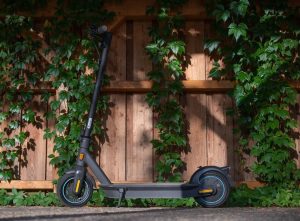E-Bikes Vs E-Scooters
 The world of micromobility options like e-bikes and e-scooters is growing every day. Deciding which one will work best for you can be a tough decision. Your lifestyle as well as what you need from the vehicle needs consideration when making your decision. In this post, we will break down the differences between e-bikes and e-scooters so that you can make an informed decision about which one to purchase.
The world of micromobility options like e-bikes and e-scooters is growing every day. Deciding which one will work best for you can be a tough decision. Your lifestyle as well as what you need from the vehicle needs consideration when making your decision. In this post, we will break down the differences between e-bikes and e-scooters so that you can make an informed decision about which one to purchase.
Comfort and Convenience
An e-bike is a great option for people with physical limitations or who are looking for an alternative to driving. The e-bike’s design makes riding them easy on the joints, unlike regular bikes which require more work from the rider. The electric motor provides power so you can ride at any speed without breaking a sweat, so it’s perfect for commuters too.
Electric bikes are perfect for people who live in hilly or mountainous areas where traditional bikes can be tough to ride. The electric motor makes it easy to pedal up steep hills but also assists the rider on long rides so novices will feel comfortable riding longer distances as well. If you’re looking to take your first bike rides or just want a little extra pep in your step, an e-bike may be the right option for you.
Electric bikes have the capability of being ridden like a conventional bike if the battery dies during a lengthy trip. Once the battery runs out of power the electrical components will automatically turn off and you will have to use pedal power until you return home or reach a place with a power outlet and that is only if you took your charging station with you.
Electric scooters are fun and easy to ride with low maintenance requirements that make them ideal for short trips around town. E-scooter riders stand on the device when riding which causes your knees to act as the suspension for the scooter. If you have joint issues the impact going over bumps in the sidewalk or road may cause soreness or other injuries. E-scooters are lightweight so you can pick them up easily when needed but also durable enough to stand up to regular use.
Electric kick scooters can be used manually in case you lose power while riding. This is due to a safety setting within the e-scooter’s power system. When riding an electric kick scooter, you must use your foot to propel it forward while applying pressure to the throttle until you reach a speed of 1.8 mph. Once the scooter reaches this speed the electric motor will kick in and off you go.
E-scooters have numerous speeds so you can choose how fast you want to go depending on where and when. E-scooters are great for people who live in crowded areas or walk or bike to work. With low noise levels, they’re great for neighborhoods with strict ordinances and they’re also easy to ride. If you want the option of going fast when necessary but don’t need a two-wheeler that can go more than 20 mph, an electric scooter might be right for you.
Range and Speed
The first question you should ask yourself when considering an electric bicycle or electric scooter is whether range or speed is more important to you?
Most people will prioritize speed, as this metric generally determines the quality of your ride. However, it’s also worth noting that scooters tend to max out at 22 mph where bikes can go up to 30 mph or more depending on the model and terrain. The best way to figure out what type of bike is right for you would be to take a test ride in person and see which one feels most comfortable. In any case, if speed isn’t your primary concern, then there are plenty of electric bikes and scooters out there that will suit your daily commute.
Early e-bike models had a limited range and would often need recharging after just 30 minutes of use. The modern e-bike has a range anywhere from 15 miles up to 100 miles depending on the type you’re buying and how much weight the rider is carrying. This means that it’s possible for people with low energy levels or those who live in rural areas without sidewalks or bike lanes to travel long distances when using an electric bicycle rather than having to rely on a car.
E-scooters on the other hand, have a limited range. Many e-scooters can only travel up to 15 miles before needing a charge. The limited range is due to the scooter using a smaller battery than e-bikes. Companies are installing larger batteries on e-scooters as the technology improves meaning the range will only go up in the future. So, if you only need to go a short distance or zip around a college campus an e-scooter may be your best option. If you are looking to travel longer distances an e-bike will be best for your commute.
Cost and Safety
Electric bikes tend to cost more than electric scooters when you get into higher-end models. The amount of money you’re willing to spend on a personal electric vehicle will depend on your budget and travel needs. That said, not all e-bikes cost more than high-end electric scooters. Some specialty and electric cargo bikes can set you back several thousand dollars, but these high-end products are the exception rather than the rule.
E-bike prices vary by brand, components, and style of bike. The price for an average e-bike ranges between $400 and $2,000 while many high-end models can reach $10,000 or more. E-scooters have a similarly broad price range with low-end models averaging $300 to $500 and high-end models costing $1,000 and above.
Safety is an important consideration when deciding between an electric bike and an electric scooter. Electric bikes are safer than electric scooters because they have larger wheels, more stability, and the ability to go on all types of terrain. Electric scooters can be dangerous if not ridden responsibly or in the right places due to their lack of safety features like lights and reflectors. No matter which one you ride you should always wear a helmet.
Now that you know the differences between e-bikes and e-scooters you can decide which one is right for your needs. Location, distance traveling, personal preference, frequency of use, how often you plan to ride over rough terrains or smooth city streets as well as cost savings potentials all need consideration when deciding on what kind of electric transportation is right for you.



